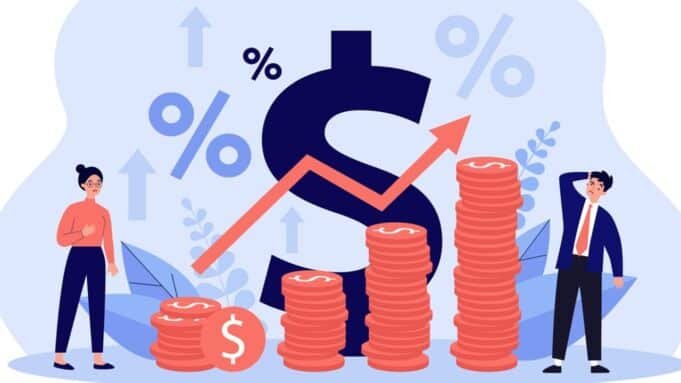Do you want to know about Who Are The Winners and Losers of the Fed hiking Interest Rates? To stabilize the economy and control inflation, the Federal Reserve (the Fed) recently announced a hike in interest rates. This significant move has far-reaching implications for various sectors of the economy, affecting everyone from big banks to the average consumer. Understanding who stands to gain and who might lose in this scenario is crucial for both investors and the general public.
The Federal Reserve’s decision to hike interest rates can have significant impacts on various sectors and individuals within the economy. In this post, we will explore the winners and losers of this policy move, highlighting the key areas affected and analyzing the implications for different stakeholders.
Understanding Interest Rate Hikes
Interest rate hikes are a monetary policy tool used by the Fed to reduce inflation and stabilize the economy. By increasing the federal funds rate, the cost of borrowing money rises, which can slow down economic growth and spending. Historically, such decisions have been both praised and criticized, depending on the economic context and outcomes.
Who are The Winners and Losers of the Fed Hiking Interest Rates?
The Federal Reserve’s decision to hike interest rates creates a distinct divide between winners and losers. On the winning side, savers and fixed-income investors find favor as they benefit from higher yields on savings accounts and bonds. Banks also gain from wider interest margins.
Conversely, the losers in this scenario are predominantly borrowers, including individuals with mortgages and personal loans, and businesses relying on debt for expansion, as they face increased borrowing costs. Additionally, sectors like real estate and high-growth industries, sensitive to interest rate fluctuations, tend to struggle, reflecting the complex impact of the Fed’s monetary policy adjustments.
Biggest Winners and Losers from the Fed’s Interest Rate Decision
In the wake of the Federal Reserve’s decision to hike interest rates, the landscape of winners and losers is starkly divided. Among the biggest winners are banks and financial institutions, which stand to benefit from increased net interest margins as the cost of lending rises. Savers and certain investors also emerge on top, enjoying higher returns on interest-bearing accounts and fixed-income assets. Conversely, the most significant losers are borrowers, both individual and corporate, who now face steeper costs for loans and mortgages, potentially slowing down investments and consumer spending.
The housing market, particularly sensitive to interest rate shifts, could see a downturn as higher mortgage rates deter potential buyers. Additionally, the stock market faces headwinds, with higher borrowing costs potentially squeezing corporate profits and investor sentiment. Thus, the Fed’s move, aimed at curbing inflation and stabilizing the economy, creates a nuanced tapestry of economic winners and losers, each impacted in complex and varied ways.
Read More: Travel Insurance International
The Potential Winners and Losers of Higher Interest Rates
The ongoing cycle of interest rate increases by the Federal Reserve, initiated in March 2022, has elevated interest rates to their highest since 2007. This scenario is advantageous for those seeking substantial returns from bonds and cash holdings, yet it poses challenges for individuals requiring loans for significant expenditures such as vehicles, education, or real estate. The dynamics of winners and losers in this scenario can vary depending on the stage of the rate-hike cycle we’re in.
These cycles of rate hikes, employed by the Fed to control inflation and cool down an overheated economy, eventually reach a juncture where a robust economy risks becoming too frail. At this point, the roles of winners and losers often reverse.
This article examines the typical patterns in the initial and latter phases of rate-hike cycles, highlighting who benefits and who suffers in each part of the cycle.
Early in the Cycle
Interest rate increases lead to higher borrowing costs, deterring consumers from engaging in substantial purchases and dissuading companies from expanding their workforce and investing. These trends, over an extended period, can alleviate inflationary pressures, though their impact often unfolds gradually.
The Winners
It’s expected that in the initial stages of higher interest rates, bond buyers, lenders, and savers stand to gain. Specifically, bond yields often increase even before the Fed implements rate hikes, allowing bond investors to secure higher earnings without incurring extra default risk, as the economy remains robust during this phase.
The Losers
As interest rates begin to rise, bond fund investors, borrowers, and certain sectors start feeling the impact:
- Bond funds, which actively trade their holdings, may initially see a decline in their net asset value. This is due to the inverse relationship between interest rates and bond prices. Nevertheless, as these funds reinvest in new bonds with higher yields, they often recuperate their initial losses.
- Borrowers with variable-rate debts, such as those with credit card balances or adjustable-rate mortgages, might notice an immediate increase in their payment obligations.
- Stocks in sectors like consumer discretionary, industrials, and materials often face underperformance in the year following the commencement of a rate-hike cycle. This is attributed to investor concerns that elevated borrowing costs and inflation will particularly diminish profits for companies heavily reliant on economic expansion.
Later in the Cycle
As elevated interest rates start to exert pressure on the economy, the risk of a recession becomes increasingly prominent. However, even amidst these conditions, there are opportunities for savers and stocks in specific industries that may benefit as interest rates approach their peak.
The Winners
Savers continue to gain advantages as interest-bearing cash investments, like Certificates of Deposit (CDs), money market accounts, and savings accounts, start offering increasingly higher yields. Presently, some of these financial products are providing significant returns, with interest rates at or exceeding 5%.
The Losers
Regrettably, in the latter stages of a rate-hike cycle, various groups, especially borrowers, encounter difficulties. Take, for instance, college students taking federal loans for the 2023–2024 academic year; they are facing the steepest interest rates seen in over a decade. The current elevated rates may also partly explain the reduction in first-time homebuyers in the U.S. housing market, which, at just 26% of total home purchases last year, hit a 41-year low according to the National Association of Realtors.
On the corporate front, issuers of high-yield bonds are particularly vulnerable to rising rates. Additionally, stocks in rapidly growing sectors like information technology may struggle as their revenues decrease while borrowing costs stay elevated.
Read Also: Travel Health Insurance USA
Winners of the Interest Rate Hike
- Banks and Financial Institutions: Higher interest rates mean that banks can charge more for loans, leading to potentially higher profits.
- Savers and Investors: Individuals with savings accounts or investments in interest-bearing assets may see higher returns.
- Certain Sectors: Industries like financial services often benefit from higher interest rates, as their revenue models are directly tied to interest earnings.
Losers of the Interest Rate Hike
- Borrowers: The cost of borrowing for both individuals and businesses escalates, making loans and mortgages more expensive.
- Housing Market: Higher mortgage rates can dampen home-buying enthusiasm, potentially slowing down the housing market.
- Stock Market: Investment portfolios may suffer as companies face higher borrowing costs and consumers reduce spending.
International Implications
The U.S.’s decision to hike interest rates doesn’t just affect the domestic market; it has global repercussions. Emerging markets, often reliant on foreign investment, may face capital outflows, while international trade dynamics can shift due to changes in currency values and investment flows.
Also Read: Best Travel Insurance for Europe
How does the Fed hiking Interest Rates Affect Banks and Financial Institutions?
When the Federal Reserve hikes interest rates, it has a direct impact on banks and financial institutions. These entities rely heavily on lending and borrowing money, and interest rates play a crucial role in their operations. As interest rates rise, borrowing becomes more expensive for these institutions, which can lead to higher costs for consumers and businesses seeking loans. Additionally, higher interest rates can also affect the profitability of banks and financial institutions, as they may have to offer higher interest rates on deposits to attract customers.
This can put pressure on their profit margins, potentially leading to reduced earnings. On the other hand, higher interest rates can also benefit banks and financial institutions by increasing the yield on their investments and loans. Overall, the effects of the Fed hiking interest rates on banks and financial institutions can be complex and multifaceted, requiring careful monitoring and analysis.
Long-term Prospects and Economic Health
In the long run, these interest hikes can lead to greater economic stability by curtailing inflation. However, they also pose risks, such as prolonged economic slowdown or potential recession if not managed carefully.
Expert Opinions and Analysis
Economists are divided on the long-term impact of the Fed’s decision. Some argue it’s a necessary step towards economic stability, while others warn of the risks of too rapid an increase in rates. The consensus, however, is that careful monitoring and data-driven decisions are essential going forward.
Conclusion
The decision of the Federal Reserve to hike interest rates has winners and losers across various sectors of the economy. Financial institutions, savers, and some investors may benefit from higher rates, while borrowers, homeowners, and consumers with debt may face challenges. It is crucial to understand these dynamics and consider the potential implications when analyzing the overall impact of interest rate hikes on the economy.
To Know More: What are Insurance Types of Insurance Benefits
Frequently Asked Questions (FAQs) about “Who are The Winners and Losers of the Fed hiking Interest Rates”
Here are FAQs about “Who are The Winners and Losers of the Fed Hiking Interest Rates”:
Who benefits from the Federal Reserve hiking interest rates?
Savers and investors in fixed-income securities typically benefit as they see higher returns on savings accounts and bonds. Banks and financial institutions also gain from wider interest margins.
How do higher interest rates affect borrowers?
Higher interest rates mean increased borrowing costs for individuals and businesses. This particularly impacts those with variable-rate loans, like adjustable-rate mortgages and credit cards, as well as businesses reliant on loans for expansion.
Do all sectors of the stock market react negatively to interest rate hikes?
Not necessarily. While sectors like real estate and high-growth industries may struggle, others, particularly in the financial sector, might benefit. The impact varies depending on how each sector is influenced by borrowing costs and consumer spending.
How do interest rate hikes impact the housing market?
The housing market often feels the pinch as higher mortgage rates can make home-buying more expensive, potentially slowing down the housing market and decreasing the affordability of homes.
Can there be long-term winners in a high-interest rate environment?
Yes. While higher rates can initially challenge growth, they are often used to control inflation, which can lead to a more stable and healthy economy in the long run. This stability can benefit a wide range of economic participants over time.















